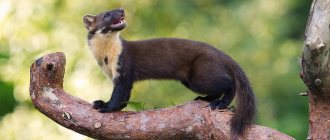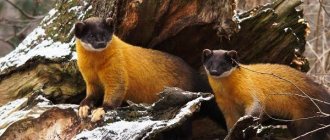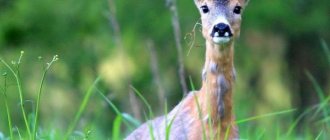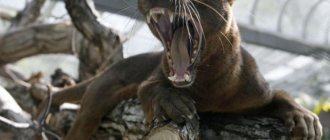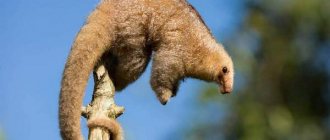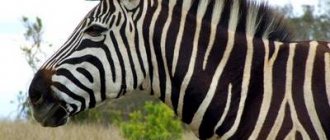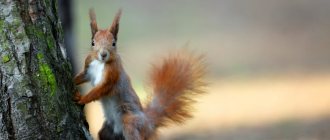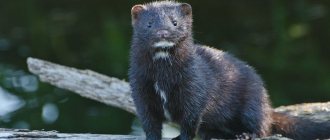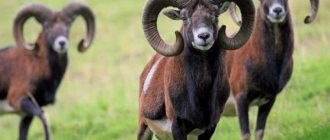The marten is a small predatory animal from the mustelidae family. The first ancient relative of the marten appeared about 35 million years ago. Currently, the genus of martens is represented by eight modern species and one extinct one.
Martens have an excellent sense of balance, the ability to quickly climb trees and make jumps up to 3-4 meters long. Their feet can turn 180 degrees, and their sharp claws and fangs cause dangerous lacerations. Such characteristics of the animal allow it to be an excellent hunter and successfully attack prey whose size exceeds its own.
In general, representatives of the marten genus are not endangered, but in some regions, due to intensive hunting and shrinking natural habitats, the populations of these animals are catastrophically declining. This became the reason for the inclusion of subspecies of the predator in the regional Red Books.
Description
The most striking and widespread member of the marten genus is the pine marten . Its strong body has an oblong shape with dense sides, the average length is 40-58 cm. The fur is thick and soft, dark brown in color, a light chestnut shade is less common. The fur on the sides is lighter than on the back and belly. The tail is long and dark in color. Its length is 18-28 cm. The height of the marten at the withers is 15-18 cm.
The paws are thick and short, each with 5 separate toes with strong, sharp claws curved down. The neck is shortened, but very mobile. On the chest there is a characteristic spot of light yellow color (in some individuals it can be bright orange). Thanks to this, the marten was nicknamed the yellowbird. The head is small with a black narrow nose. The eyes are dark and round, set close to the nose. At night they glow with a reddish tint.
The rounded ears stick out vertically. Along their inner edges, like a rim, there is a light stripe. The mouth is narrow, but quite deep with small teeth in the shape of a triangle. There are large fangs on the sides of the upper and lower jaws. On both sides near the nose there are thin, stiff mustaches. The average weight of a marten is 1.3-2.5 kg.
Where does the marten live?
Photo: Pine marten
The pine marten can be found in Europe, northern Asia and the Caucasus. In the territory it lives on tall trees of the Urals and Western Siberia. Sometimes it can be found in Moscow city parks: Tsaritsyno and Vorobyovy Gory. Gradually, the sable unscrupulously pushed it out of the range of the Ob River; previously it was found there in sufficient quantities.
Sable occupied a wider territory: Siberia, northeast China, Korea, northern Japan, Mongolia, and partly the Far East. Unlike the pine marten, it prefers to run on the ground rather than climb trees, and loves to live in coniferous rather than deciduous forests. These sedentary animals rarely change their location, only in severe cases: fires, lack of food or oversaturation with predators.
Kidas, as the heir of the pine marten and sable, lives in the places where these predatory individuals intersect. According to eyewitnesses, it is most often found in the Pechora River basin, in the Trans-Urals, Cis-Urals and northern Urals. Like the sable, it prefers a terrestrial existence.
The pine marten, unlike its relatives, loves a warmer climate and lives further south. The habitat covers almost all of Eurasia and stretches from the Pyrenees to the Mongolian steppe and the Himalayan ranges. Loves steppe terrain with numerous bushes. Some populations feel good at an altitude of 4000 meters, which is why they got their name.
Kharza prefers a hot climate and lives even further south than the pine marten. There is quite a lot of it on the Hindustan Peninsula, Chinese plains and islands. It is found in Malaysia, as well as the Amur region, Primorsky and Khabarovsk territories. Some residents of the Amur region sometimes also encounter harza, but less often.
Peculiarities
The marten is an agile and agile predator. Despite its short legs, it is capable of moving at high speed with large leaps (up to 4 m in length), leaving traces of its hind legs on the marks of its forelimbs.
With the same ease, the animal moves to heights, digging its claws into the bark of a tree. In this case, the feet tend to rotate to the sides by 180 degrees. The marten can half hide its claws inside and release them at the time of hunting or danger.
The tail not only decorates the animal, but is also an important tool. It helps the body maintain balance in an upright position, move boldly along thin branches and jump from one tree to another. Thanks to its tail, the marten can fall softly from great heights without causing harm to itself.
On the stomach, close to the tail, there is a special gland called the anal gland. It secretes a special liquid - a secret. Females have 2 mammary glands. The soles of the marten's paws are bare in summer, and in late autumn they begin to grow hair, thanks to which the animal easily moves through the snow without falling into snowdrifts. The coat also varies by season - in winter the fur is long and silky, with an undercoat of light colors. And in the summer months it thins out, becomes shorter and coarser.
The marten has a keen sense of smell, excellent hearing, and moves freely in the dark. She has well-developed motor skills of her limbs. This animal can swim, but tries to avoid water, preferring to be at heights or move on land. Males are more active and always larger than females.
These predators are capable of making a variety of sounds - a menacing growl or abrupt bark, like dogs, or meowing and howling, like cats. The marten in the photo looks like a cute, defenseless creature, but this is a deceptive impression - it is an insidious predator and knows how to stand up for itself. Kills prey with a deep bite to the back of the head.
Following in the footsteps of forest animals
The pine marten gave its name to a large group of forest animals - the mustelidae family.
She is a typical representative of this family. Her elongated body exudes flexibility and mobility. With equal agility, the animal moves on the ground and along tree branches. The marten is found throughout the forest and forest-steppe European part of the country, in the mountain forests of the Western Caucasus and in small numbers in the taiga of the Trans-Urals, east to the Ob. The size of the marten, compared with those of other representatives of the mustelidae family, is average. Body length 40-58, tail 20-26 centimeters, weight 1200-800 grams; the female is somewhat smaller. The lush and soft fur of the animal has been famous since time immemorial. The general tone of its winter color is dark brown, more intense on the upper part of the body and lighter, with a fawn tint, on the belly. On the throat, in the lower surface of the neck, there is a light (yellow, orange or brown) spot, which sometimes extends to the chest. Because of this spot, the pine marten was previously called the yellow marten, in contrast to the white marten, a stone marten that lives in the southern regions of our country. In areas of the European North, martens prefer to settle in spruce forests. In pine forests there is always less of it, since there the number of mouse-like rodents, the main food of this predator, changes more sharply than in spruce forests. Within its range, the marten is distributed unevenly. This is due to the degree of forest cover in a particular area, the feeding capacity of the land, the availability of food in different seasons and the presence of nesting conditions. In those places where the animal is not persecuted, it easily gets along in the immediate vicinity of populated areas, easily tolerates even an anthropogenic landscape and can stay in a small forest island with an area of several hundred hectares. The number of martens varies slightly over the years. This is explained by its polyphagous nature and the ability to switch from one food to another, i.e., to compensate for the lack of main food at the expense of secondary ones. The food range of this predator is large and extremely varied. Its main food is forest voles and forest birds, mainly hazel grouse. The marten also eats squirrels, small birds and their eggs, frogs, lizards, insects and their larvae, and is very fond of honey. Her plant food consists of various berries, primarily rowan. In the southern part of its range, the animal also eats the fruits of wild fruit trees and grapes. Males are capable of attacking such relatively large animals as the white hare and wood grouse, but this is a rather rare prey for a predator. In general, the male’s food range is noticeably more varied than the female’s. In the Arkhangelsk region, for example, in the diet of a male there are 11 food items in winter and 14 in summer, while a female has 6 food items in winter and 9 in summer. than males, they eat small birds, insects, shrews, as well as plant foods. Males with greater physical strength and, in particular, stronger jaw muscles, make fuller use of the potential food supply. The difference in nutrition between males and females is beneficial for the species, as it leads to a more rational use of food reserves in nature when obtaining food. The marten's stomach holds 130-150 grams of food - this is the optimal daily requirement. Typically, the stomach of a hunted marten contains from 60 to 90 grams of food. The marten provides itself with food and does not follow in the footsteps of other predators. At the same time, its reserves and scraps are picked up by such “freeloaders” as the fox, ermine, and in the northern part of the range, wolverine. The best shelter for this predator is the hollow of an old tree. In spruce-broad-leaved and mixed forests there are many hollows, and their presence does not limit the distribution of martens. In clean spruce forests there are fewer of them, and here the predator often uses a squirrel’s nest for housing. The marten's rut occurs in July-August. Pregnancy lasts 230-275 days. The development of embryos is delayed at an early stage and resumes only at the end of winter, and therefore during the fishing period it is impossible to distinguish a pregnant female from a barren female by its internal organs without special research. In April-May, the female gives birth to three to four blind cubs, which gain their sight at the age of one month. In the fall, the brood disintegrates, and by the fishing season, the young of the year are almost no different in growth from adult animals. The marten’s entire life takes place within a fairly clearly defined area of the forest - this is its individual habitat. In males and females, the areas are most often adjacent, and sometimes partially coincide. The growing young remain on the mother's site until autumn, and disperse in late autumn or early winter. At this time, traces of martens appear in areas where they were not previously present. If the young of the year do not find free areas in the depths of the forest, they move to the edges, small forests, young plantations, forest islands among clearings and burnt areas, and generally to lands of poorer quality. Most of the young animals in these lands are hunted in the first season by hunters. The sizes of individual marten areas vary. In the northern part of the range, where food is scarce, they are extensive; in the southern regions, richer in food, they are smaller. For example, on the Kola Peninsula, marten hunts in an area of up to 50 square kilometers, in the middle zone - 5-6, and in the Caucasus, often less than one square kilometer.
Rice. 14. Imprints of the front (above) and rear blunder of a marten
Rice. 15. Marten tracks on loose snow In the snow, the predator leaves characteristic five-fingered paw prints, very large for such a relatively small animal. This is explained by the fact that in winter the soles of lal martens are overgrown with thick, hard hair and their supporting surface increases sharply, which makes it easier for the animal to move in loose snow. In this regard, the marten's tracks have soft outlines, the pads of the fingers are faintly imprinted on the snow, and the tips of the claws leave noticeable marks. They are especially clear during a thaw, on wet snow, when, as hunters say, the animal leaves a “printed” mark. Usually the marten moves by jumping - galloping, leaving paired paw prints, and placing its hind paws exactly in the prints of the front ones. When running this way, the animal, as if changing its pace, moves its right or left paw a little forward. The length of the jump depends on the speed and condition of the snow cover. At fast speeds and in dense snow it is 60-70 centimeters, on ascents, descents or at slow speeds 40-50.
Chasing a hare or escaping from enemies, the marten runs in a quarry: prints of four, less often three, paws are left on the snow, with the prints of the hind paws in front of the front ones. Hunters call such a trail “four-chet” or “three-beam.” This is a rare gait of the animal. When searching for or storing prey, the marten walks in small steps and the paw prints are located not in one line, but in a zigzag pattern, in a herringbone pattern. Deep and loose snow makes it difficult for the predator to move. despite the width of her paws. In such conditions, her jumps are short, 30-35 centimeters, and she plunges 9-10 centimeters into the snow. Marten tracks are difficult to confuse with the tracks of other animals. However, her four-bead tracks are somewhat reminiscent of the jumps of a mountain hare. They also have some similarities with sable tracks. In those places where both of these animals live, the track encountered can sometimes be perplexing: it can be difficult to find out from it whether a sable or a large marten has passed through here. Zoologist V.V. Raevsky, who worked for a long time in the Northern Urals, noticed that the sable, unlike the marten, has more elongated paw prints and shorter jumps. In addition, according to the hunters, he notes that when jumping, the sable places its paws parallel, while the marten places its paws somewhat differently: with its heels together and its toes apart. When tracking an animal, its sex can be determined not only by the size of the mark, but also by its urinary points, of which there are at least a dozen during the daily course of the marten. If a bright urine spot, standing out sharply on the white snow, is located between the elongated prints of the hind paws, it means that a female has passed through here, but if some object away from the print of the hind paws has been sprayed with urine, it is a male.
In summer, the marten leaves barely noticeable marks. However, its presence in the lands during the snow-free period can be established by excrement, which is found on stumps, wells, trunks of fallen trees, on protruding roots at the butt of a tree, on old anthills, and sometimes just on the path. Marten excrement, eight to ten in length and one to one and a half centimeters in diameter, is sausage-shaped, usually spirally twisted, and its ends are pointed and elongated. It is easy to notice in them the remains of undigested food: small bones of mouse-like rodents and birds, wool, feathers, pieces of chitin, seeds, berry shells, etc. The droppings have a musky odor that lingers for a long time. Many people believe that the marten leads a semi-arboreal lifestyle. However, the closer you get to know the life of this animal, the more convinced you are that this is not so. Tracking the marten convinced me that it is a true terrestrial predator. I walked hundreds of kilometers in marten tracks: no more than one percent of this path was on horseback. Only in order to rest, when chasing a squirrel and feeding hazel grouse, the marten of its own free will climbs a tree and moves along the branches. The marten obtains its main food on the ground. In the second half of winter, when due to the depth of the snow, she even settles down for the day in rented shelters - under heaps of brushwood, in hollows, in voids under windbreaks, hidden snow, where it is warm and safe. It’s a different matter if the marten is being pursued by enemies. Agile and agile, she rarely becomes a victim of larger predators, but she is still caught by a fox, lynx, wolf, eagle owl or golden eagle. It is in these cases that the marten uses its ability to escape in trees. Once, in the Prioksko-Terrasny Nature Reserve, I read from the tracks that a fox attacked a marten, digging out from under the snow the remains of a hare that had not been eaten by some predator. The marten jumped onto the nearest spruce and, despite the fact that the fox gave up pursuit, covered more than a hundred meters, jumping from tree to tree, before descending into the snow. A marten is riding while being pursued by a hunter with dogs. This is precisely what served as the reason to consider it a semi-arboreal animal. The nature of the marten's hunting pattern varies depending on the type of land and the prey it encounters in one place or another. On the outskirts of clearings or in sparse forests, the animal’s trail spreads in a straight line. Its main prey in such places is black grouse, white partridge, and sometimes capercaillie. These birds spend the night under the snow, and in order to find evidence of them, a predator must travel a long distance. From a distance, following the footsteps of the merchant, he notices bird feeding areas, slows down, stops and then walks around.
Approaching three to four meters to a sleeping bird, it apparently instinctively determines the place where it is hiding under the snow and rushes towards it in sharp short leaps. In sparse stands, the animal, as if playing, often jumps three to four meters onto tree trunks while running, and then jumps onto the snow. Apparently, these jumps help navigate the terrain. When hunting in spruce forests, the marten leaves a different type of trail. Here she moves in short jumps, and sometimes in steps. Its path is winding, stretching from one windbreak to another. The predator constantly climbs under the rubble of trees, but it is not possible to trace its hunt in labyrinths or under snow-covered snags. Sometimes, if you look under a pile of dead wood, you can find the feathers of small birds: tits, woodpeckers, jays or cuckoos.
Rice. 17. Unsuccessful marten hunt: 1 - search; 2 - stacking the loot; 3 - throw at the bird; 4 - take-off of the black grouse In severe frosts, birds climb to spend the night in the voids under the rubble, and therefore become easy prey for martens. Here, in the spruce forest, while examining the rubble, the marten comes across roosting hazel grouse and catches them more successfully than other forest birds. But most often in such places the predator manages to catch voles, which serve as its main food. The trail of a marten going for the day is relatively straight; the animal does not scour from side to side, as when searching for prey. Heading to the shelter, the marten usually walks the last ten meters on horseback, even if the entrance to the hollow is located at the base of the tree. Staying hunting until dawn, which often happens, the marten may encounter a squirrel that has already gone out to feed. More than once I had to read from the tracks how a predator rushes to catch a squirrel digging a cone out from under the snow, and it usually leaves it on horseback, easily jumping from one tree to another. The fact is that a marten, much more often than a squirrel, has to jump into the snow and climb up the trunk again, since it cannot jump from a high tree to a low one, like a squirrel. This is explained by its large weight and shorter fingers, which are not typical for the poison dart frog.
Catching a squirrel is not an easy task for a marten. However, in years when squirrels are numerous, they more often become victims of predators, since sick and weak, i.e. non-viable, individuals appear in their population and it is not difficult for a marten to catch them. When the number of squirrels is low, as a result of natural selection of the first population, only healthy animals are preserved, which are much more difficult for a predator to obtain. Therefore, in years of low squirrel numbers, the marten practically stops pursuing these rodents, although on its daily search route it repeatedly crosses their tracks. The daily movement of the pine marten in the taiga of the Onega Peninsula, according to my observations, in some cases can reach 14 kilometers. On this long path, the predator goes under the rubble more than a hundred times in search of Rodents, looks through dozens of bog bird holes, makes several throws to catch a hazel grouse, before it manages to provide itself with a daily diet: approximately four to five voles. Having caught a larger prey (squirrel or upland bird), the marten remains in the nearest shelter for two or three days, content with the supply of food. Often the daily movement does not bring her luck, and she limits herself to visiting the places of previous successful hunts, where she gnaws bones and tendons again. Eating carrion by a marten also serves as an indication that this predator with a wide food specialization often experiences difficulties in obtaining food. That is why one or two animals remain near the corpse of an animal or near the entrails of an elk caught by hunters for a long time, until the supply of food by them or other predators is completely used up. The smell of carrion is very attractive to the marten. The incident convinced me of this. In the taiga of the Onega Peninsula, on the shore of a forest lake, I discovered a perennial nest of a golden eagle. On the ground under the nest and under the neighboring pine trees, which served as a perch for the bird, there was a mass of bones - the remains of the predator's victims. Among the bones belonging to hares, muskrats, hog and waterfowl, I collected parts of the skeleton and skull of ten martens. Some of them stayed here for more than five or six years. It is unlikely that a golden eagle, a large bird with a huge wingspan, can catch a marten, an agile and fast land animal that is nocturnal, among dense vegetation. The golden eagle does not hunt at night and, apparently, only the instinct to protect the chicks forces it to kill the animals that were attracted to the nest by the smell of the abundant remains of the numerous meals of this feathered predator. Many forest predators can compete with the marten for food. The main one is the fox. In the European North, this has become especially noticeable in recent decades, when, following deforestation, the fox penetrates into remote areas where it was not previously present.
The composition of the food of these two predators in the forests of our Non-Black Earth Region is very similar: for both, the main food is voles and upland birds. These predators, one might say, “divided” the voles among themselves : the marten eats mainly red forest voles, and the fox eats more often large and less mobile gray ones, which stick to more open places. But upland birds - hazel grouse, partridge, black grouse and, to a lesser extent, capercaillie - are common food items for both predators. Watching martens in the remote taiga corners of the Onega Peninsula, where the fox had not yet penetrated, and in the Vologda forests, thinned by logging, where there are many foxes, I noticed a difference in their behavior. In the north, the marten, having caught a hazel grouse, partridge or other bird and having had enough, hides the remains of food somewhere under logs or simply buries them in the snow and returns here the next night or after an unsuccessful hunt. In the Vologda forests, all the remains of the marten’s food are found and eaten by the fox, and therefore the martens have adapted to drag them up a tree and in this way save them for themselves. The marten has an amazing ability to remember places where food remains were hidden after a successful hunt. Once I was following the trail of a marten and clearly imagined how the animal, crossing a small moss swamp, seemed to remember something: it sharply turned at a right angle to its course and in large leaps headed towards an old stump sticking out of the snow, two to three hundred paces away. aside. Near the stump there was a black hole in the snow, into which a marten climbed. The exit trail showed that it was no longer there, but in order to find out what the animal was doing there, the hole had to be dug up. Under a meter-long layer of snow and a little to the side, between the splayed roots of a stump, the remains of the marten’s former meal were discovered - bones with tendons, tail and flight feathers of a capercaillie. The marten got the bird a long time ago, maybe even before the snow fell, and feasted here, probably, for several days. Now bare frozen bones are useless to her, but she loves to visit the places of previous successful hunts and remembers them well on her site. There was a case in the Bashkir Nature Reserve that confirmed the marten’s good memory and knowledge of its area. The predator ravaged the wood grouse's nest, stole and hid the hatched eggs. Only in the middle of winter, following the tracks, it was noticed that she visited this area and dug out from under the snow an egg that had been hidden six months ago. Even before the October Revolution, the pine marten population in the European North was undermined by predatory fishing. In the vast taiga areas it was completely exterminated. Only a long ban on hunting in Soviet times restored the marten population in its former range, and currently, in all northern regions of the European part of the country, licensed fishing for this valuable fur-bearing animal is permitted.
Kinds
The marten genus contains several species and subspecies, each of which has its own characteristics. The most common types are the following.
- Stone marten (white marten). Her fur is short and dark gray. There is a white spot on the neck that stretches to the front legs and bifurcates, and there are individuals without a bib at all, just gray. It is similar in size to the wallflower, but heavier in weight. Her nose is light, and the skin between her ears is paler than on her body. The feet are not covered with hair.
She is the bravest among her brothers, makes nests close to people's houses, and hunts domestic animals. He does not like to jump into trees; for hunting he chooses open expanses of plains with bushes and forest plantations.
It is capable of living in the mountains, at an altitude of more than 4 thousand m, as well as in rocky areas with sparse foliage, which is why it received this name. The fur of this marten is less valuable than that of other species.
- Kharza or Ussuri marten. One of the largest representatives of the genus. It reaches a length of up to 80-90 cm and weighs more than 5.5 kg. The color is unusual - the head, end of the back, hind limbs and tail are dark or black, and the body is of variegated shades.
The body palette is very diverse: bright red, yellow, pale sand or with multi-colored stripes. The lower jaw is white. The fur is short, with a thick undercoat. This marten can remain in one place on rare occasions; it does not experience any inconvenience when migrating over large areas.
- American marten. The body structure is typical of martens, but smaller in size than their counterparts. The male’s body is 35-45 cm long and weighs no more than 1.5-1.7 kg. Females grow up to 40 cm and weigh about 1 kg. The color of the skin is brown or light chestnut, and the tail, paws and nose are dark in color.
Some individuals have 2 dark stripes near the eyes. The fur is long and soft, the tail is fluffy. Martens of this species are very cautious and timid, emerging from cover only under the cover of darkness.
- Nilgiri Kharza. A rare representative of its kind. The dimensions of this animal exceed average, body length 60-70 cm, weight more than 2.5 kg. It cannot be confused with other martens due to its unique coloring. The whole body is dark brown, and on the chest there is a bright orange spot, which bifurcates near the front legs. The nose is pink, the frontal bone on the skull is noticeably arched.
- Ilka or fishing marten. It can compete in size with the harza, growing up to 90 cm in length and weighing more than 5.5 kg. The fur is long and thick, but tough. From a distance, this marten appears black, only up close it is possible to see that the head and neck are lighter than the body, and the fur is brown. Some animals have a white spot on the chest with a grayish tint. The paws are thicker than those of other martens, which allows them to confidently move through deep snow.
There is also an animal called kidas (or kidus) - this is a natural mixture of sable and marten. He adopted his appearance and habits from both parents. Kidas males are sterile, so they cannot reproduce.
Marten and man: facets of interaction
Relationships between humans and animals can be very different. Predators can pose a direct threat to human life or farm animals. In this regard, martens somewhere in the Moscow region try to stay away from settlements. They do not pose any danger to human health and life, except in a situation where the person himself forces the poor animal to defend itself and protect its offspring.
Of course, there is a possibility that during the winter lack of food, the animal will climb into the chicken coop and take the chicken to its dense forest. However, this happens extremely rarely. There is another explanation for the arrival of martens to places where a person lives himself, stores his supplies and keeps pets. This is the destruction of the natural habitat of these animals.
There are fewer and fewer forests, and more and more houses. At the same time, it is the mixed forest zone that suffers the most, where the marten has until now found food and shelter in sufficient quantities. Deforestation and development, of course, greatly destroy the natural habitat of martens. However, the pyrogenic factor can be considered the most destructive.
Crown fires destroy trees completely, forming grass or grass-shrub thickets in place of the forest. Pine martens cannot live in such conditions. The surviving animals, if they have nowhere to migrate, try to feed, reproduce and winter in the ashes. As a result, they are forced to visit people's homes, which usually ends badly for them as well.
If fires are low (grass, litter, shrubs, undergrowth burn) and frequent, trees suffer pyrotrauma. After several years of such fire exposure, the tree may burn out and fall. So frequent ground fires lead to the same result as high fires. Only the process happens more slowly. For martens and other arboreal animals, the result is the same - death from lack of food, migration to forests that have not yet burned, and raids on rich human bins.
The conclusion is simple - do not destroy the marten’s biotope and it will avoid your homes. This animal loves to live in deep forest thickets, where there is something to feed and a place to hide. Leave him such thickets and he will not be interested in your farming.
Lifestyle
The marten is a solitary animal . It does not create a family; males and females meet only to conceive offspring; the rest of the time they live and hunt separately. The exception is the Ussuri martens, which are capable of chasing game in a flock of 4-5 members.
Each individual has its own territory with an area of 5-30 km, and the boundaries are marked with urine and secretions from the anal gland. The dwellings of males are always larger than those of females and can overlap with the female domains.
The predator can live on its lands for years, but does not have a permanent home. For rest, he selects 5-6 places, which he also marks and constantly changes. Any shelter is suitable as a shelter, preferably at a height:
- hollow or crevice higher than 2 m from the ground;
- squirrel hole;
- bird's nests;
- deep gorges between stones.
They are usually friendly towards each other. Males can fight either for a female during the mating season or for territory; in other cases, aggression does not manifest itself. Martens are nocturnal - they hunt and play in the dark, and sleep during the day. Only the Nilgiri harza is active during the daytime, while the ilka forages for food at any time of the day.
They can leave their area if they are chasing squirrels, while trying not to go down to the ground unnecessarily, but to pursue prey by jumping on branches. These animals are cautious and avoid people.
Only the stone marten wanders without fear near human habitation and raids pens with domestic animals. The marten constantly moves in search of food, and only in winter it lies in shelter for a while and feeds on previously prepared food.
Pine marten behavior
The pine marten lives up to its name, since none of its relatives is found so often in forests and trees.
This animal climbs and jumps well, capable of covering a distance of 4 meters in a jump. When a pine marten crawls, it turns its feet at an angle of about 180°. Pine martens choose shelters in hollows, or they occupy abandoned structures of squirrels and nests of birds of prey. In such shelters, animals rest during the day, and at dusk and nightfall they go in search of their prey.
Pine martens have very pronounced territorial behavior; they mark their area of residence with the help of a secretion secreted by the anal gland. The areas of males and females of this species may overlap, but animals try to drive away individuals of their own sex from their territory. The size of the site varies quite a lot, but usually males occupy larger areas than females. In addition, summer territories always exceed winter ones in size.
Habitat
The distribution area is very wide. The marten lives in almost all forested areas and mountain ranges with dense vegetation, where there is a temperate or cold climate. Favorite environments are wide deciduous, coniferous or mixed areas with perennial trees and abandoned edges. Animals are distributed according to their characteristics:
- the pine marten prefers pine, coniferous and mixed forests of Europe and the northern part of Asia, has chosen the massifs from Western Siberia to the Baltic Islands, it also lives in the Caucasus and the south of the Mediterranean;
- the stone marten is found on rocky terrain throughout almost all of Eurasia, from the Himalayas to the Iberian Peninsula, and it was also artificially populated in the state of Viscontin (USA);
- Kharza inhabits the Ussuri and Amur regions of Russia, the eastern and southern parts of China, the Himalayan mountains and eastern Asia;
- The American marten lives in North America; it has inhabited forests from New Mexico to northern Alaska;
- the Nilgiri marten lives in the highlands of the Nilgiria, in the mountain ranges of the Western Ghats - only this species can be found in southern India;
- Ilka lives in the east, west and center of North America, including the mountainous regions of California to the borders of West Virginia.
The Japanese sable is a rare species of the genus of martens, and it lives in small numbers on the Japanese islands (Kyushu, Shikoku, Honshu), as well as in North and South Korea.
Tyva Republic
Status: IV category. Species of uncertain status.
Spreading
On the territory of Tuva, it is distributed in the mountain systems of the Chikhacheva, Shapshalsky, Tsagaan-Shibetu, Western Tannu-Ola ridges at altitudes of 1600–3000 m above sea level. m.
Number
No special accounting was carried out. According to expert estimates, the number may be up to 500 individuals. Population density is sparse throughout its range.
Source: Red Book of the Republic of Tyva (animals, plants and mushrooms). Ed. S.O. Ondar, D.N. Shaulo (2018) Kyzyl
Nutrition
The marten is an undemanding predator in food, but its main diet is animal food. It hunts all small rodents, birds, large insects and even hedgehogs that inhabit its territory.
If there is a body of water nearby, frogs, snails, larvae, fish and their eggs are added to the menu. This animal steals laid eggs and eats honeycombs from wild apiaries. Favorite dishes: squirrel, vole, shrew, black grouse, capercaillie and others.
The marten loves fresh food, but does not disdain carrion. In the summer months, omnivores eat wild berries, rose hips, wild apples and pears, and nuts. Rowan occupies a special place in the diet. It is frost-resistant and its composition has anthelmintic properties. Predators eat it all year round, picking berries while sitting on the branches.
What does it eat?
The marten is an omnivore. The main part of the diet consists of rodents, reptiles, insects, and small birds. The animal can also destroy bird nests located on tree branches and on the ground. If there is a body of water near the hunting grounds, snails, frogs, and fish fry are eaten.
During periods when there is very little animal food, the predator switches to a plant-based diet, eating nuts, wild berries, seeds, and the fruits of wild apple and pear trees.
The marten is the worst enemy of squirrels: it is capable of chasing a rodent that comes into view for a long time, overtaking it in a tree or in a hollow. Often, after a successful hunt, martens use squirrel nests as temporary resting places.
The predator can eat carrion, although it does so reluctantly and when absolutely necessary.
Reproduction
Martens become sexually mature at 2 years, but usually produce their first brood in the 3rd year. In February, mating games occur, but they are called “false rut” because conception does not occur. Individuals mate in June-July, at which time the females begin estrus, which lasts 2-4 days. There are several of them over the summer, the break between them is 1-2 weeks. One male fertilizes 3-5 females.
The egg does not immediately attach to the uterus; first there is a long latent stage, and the embryo itself develops in only 30-40 days. Before giving birth, the mother looks for a place for her offspring, choosing secluded spacious nests or an old hollow. Pregnancy lasts 8.5-9 months, after which blind and deaf cubs appear in March-April. The marten brings 2-4 babies at a time, in rare cases 5-7 animals are born.
The weight of a newborn is 30-40 g, the length of the body is 100-110 mm. Babies are covered with thin and short fur. They have no teeth, for the first 40-45 days they feed on their mother’s milk and actively gain weight. The mother leaves the nest to hunt, and in case of danger, drags the brood to another place. The first thing babies develop is hearing (after 20-25 days), and after 5-7 days their eyes open.
At 7-8 weeks, the first teeth erupt, and the cubs switch to solid food and begin to emerge from shelter. At 2.5 months, babies are actively moving, their mother introduces them to the world around them and teaches them to hunt. At 16 weeks, puppies know and can do everything, but until September they live near their mother. In the fall, the family breaks up, and everyone leaves to look for their place.
Lifespan
In captivity, the marten takes root reluctantly and in different ways - either it becomes domesticated, or it shows aggression. If the outcome is favorable, she can live up to 15 years or more. In the natural environment, a valuable predator can live 11-13 years, but in reality it rarely reaches that age. The animal is vulnerable to parasites and infections that lead to its death.
Also in the wild, other species of forest inhabitants see the marten as both a competitor and a possible meal. Its most active enemies are fox, lynx and wolf, as well as agile birds - eagle owl, golden eagle and hawk.
But the main culprit in the extermination of animals is man. Marten fur has always been expensive. Even in widespread species such as stone marten or yellowjacket, it has never been cheap.
Natural enemies of the pine marten
Previously, the fur of pine martens was valued much more than the fur of stone martens. In the Middle Ages, townspeople and nobles loved to wear it, catching animals for this purpose, setting traps and snares. Due to active hunting for this reason, the pine marten has become a rare animal in many regions of its habitat, but in general its extensive range saves the species from becoming endangered. The problem for the life of this species today is the fact that its natural habitat is steadily shrinking, since the pine marten absolutely needs a healthy forest. The main natural enemy of the pine marten is the golden eagle.
Marten hunting
The marten is a valuable game animal. The hunting season begins in November and lasts until March, while the animal’s fur is thick and fluffy. In the spring, the skin becomes dull and molts, and then the predator is destroyed only as a pest (usually the stone marten, which annoys farmers). Martens are most often caught with traps and self-catchers.
Nilgiri harza and Japanese sable are protected by law. Hunting marten of any of these unique members of the mustelid genus is prohibited. Hunting for other predators is permitted with a one-time license, the cost of which depends on the type of animal. When catching marten without this document, hunting is considered poaching and is prosecuted by law.
Interesting facts about the pine marten:
- Keeping a pine marten in captivity is a rather difficult task and therefore this species is rarely seen in the zoo. Its largest populations were created in zoos in Hankensbüttel and Innsbruck.
- When the pine marten hunts, it is capable of jumping from branch to branch over distances of up to 3 meters.
- The games of pine martens are very similar to those of cats.
- In dangerous situations, pine martens emit a sharp squeak. During the breeding season, their piercing screams and snorts, which resemble the purr of a cat, are heard every now and then in the forest.
- The pine marten is called the yellowbird because on the animal’s chest there is a yellowish or orange spot that does not bifurcate. This is also a distinguishing feature of this species from the related rock marten, whose spot is white and forked at the back. In addition, the size of pine martens is smaller compared to stone martens; their nose is dark, while stone martens are pink.
